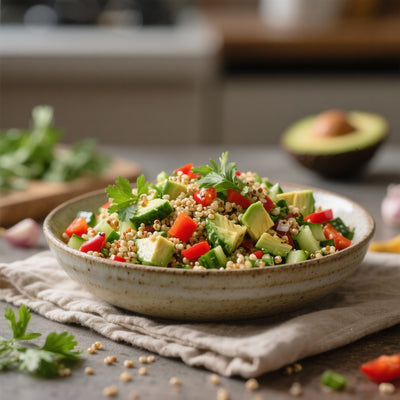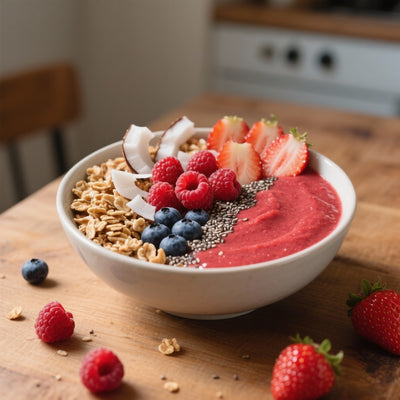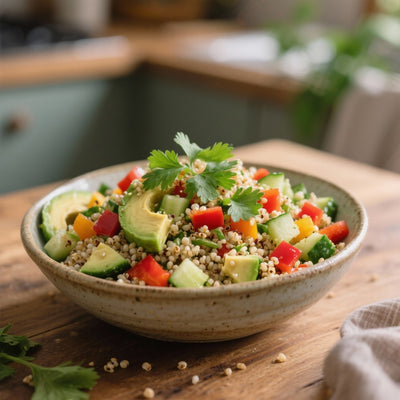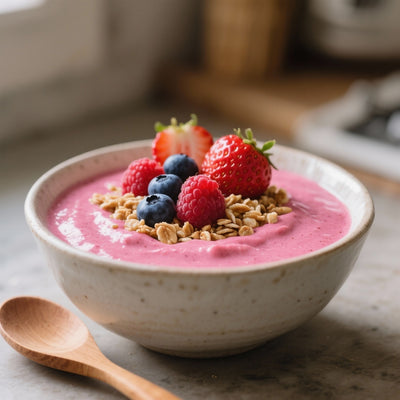Hyaluronic acid vs. Shilajit: Which approach for skin hydration?
Introduction
The quest for perfectly hydrated, supple, and youthful-looking skin is a universal journey. In this world teeming with skincare products, two names stand out, despite coming from radically different backgrounds: hyaluronic acid , the undisputed star of cosmetic laboratories, and Shilajit , an ancestral treasure from the Himalayan mountains.
One is a powerful humectant, a veritable molecular sponge celebrated for its immediate plumping effect. The other is an organic mineral complex, a regenerating substance that nourishes the skin from within. Faced with this dilemma—modern science versus age-old wisdom—how to choose?
This article goes beyond a simple comparison. We'll break down their mechanisms of action, their respective benefits, and their limitations to help you understand not which one is the best, but which one is best for you . Get ready to redefine your approach to skin hydration.
Hyaluronic Acid: The Undisputed Pillar of Hydration
Hyaluronic acid (HA), ubiquitous in serums, creams, and even injectables, has become synonymous with hydration. But what really lies behind this miracle molecule?
What is hyaluronic acid?
Hyaluronic acid is a glycosaminoglycan, a type of polysaccharide (a complex sugar) naturally present in our bodies. It is found in abundance in the skin, connective tissue, and eyes. Its main role is to lubricate joints and, above all, to maintain skin hydration and structure.
Its superpower lies in its phenomenal ability to retain water: a single molecule can attract and bind up to 1000 times its weight in water . This property makes it the ultimate moisturizer, acting like a molecular sponge that saturates the skin with moisture.
How does it act on the skin?
The action of hyaluronic acid depends on its molecular weight. High molecular weight molecules are larger and remain on the surface of the epidermis. They form a non-occlusive protective film that prevents water evaporation (transepidermal water loss) and visibly smooths the skin.
Lower molecular weight molecules, being smaller, can penetrate deeper into the layers of the epidermis. They deeply hydrate and stimulate collagen production, contributing to firmer, more elastic skin over time. A good serum often combines several molecular weights for comprehensive action.
"Did you know that the body's natural production of hyaluronic acid decreases by almost 50% between the ages of 20 and 50? This decline directly contributes to the appearance of fine lines, loss of firmness, and skin dehydration."
Advantages and Limitations of Hyaluronic Acid
Its benefits are undeniable and quickly visible, which explains its popularity.
- Immediate plumping effect: Skin is instantly smoother, dehydration lines are filled.
- High tolerance: Being a natural molecule in the body, allergic reactions are extremely rare.
- Versatility: Suitable for all skin types, from the oiliest to the most sensitive.
However, hyaluronic acid (HA) is not without its nuances. Its effect is primarily symptomatic and temporary. In a very dry environment, a poorly formulated product could paradoxically draw moisture from the deeper layers of the skin to the surface, exacerbating dehydration if it is not sealed in with an occlusive cream. It is a hydrating agent, but not a nutrient.
The Shilajit: The Millennial Treasure of the Mountains
Less known to the general Western public but revered for centuries in Ayurvedic medicine, Shilajit is a powerful natural substance, often called "the sweat of the mountains" or "black gold".
What is Shilajit?
Shilajit is an organo-mineral resin that oozes from the rocks of major mountain ranges, particularly the Himalayas. It is the product of the very slow decomposition of plant matter and minerals over thousands of years. This long maturation process imbues it with a unique concentration of nutrients.
Its most valuable component is fulvic acid , a natural transporter that improves the permeability of cell membranes, allowing the more than 85 minerals and trace elements it contains to be better absorbed by cells. It is also rich in antioxidants, humic acid, and dibenzo-α-pyrones.
How does it act on the skin?
Shilajit's approach is fundamentally different. It doesn't just provide water. It acts as a biostimulant , nourishing skin cells so they function optimally.
- Antioxidant action: It neutralizes free radicals, which are responsible for premature aging.
- Collagen stimulation: Minerals and fulvic acid support the synthesis of collagen and elastin, improving firmness and elasticity.
- Cellular energy: It helps optimize ATP production (the energy of cells), promoting skin repair and regeneration.
- Anti-inflammatory properties: It can soothe irritated skin and reduce redness.
The hydration it provides is a consequence of improved cellular health, not its primary purpose. For more information on holistic approaches to wellness, feel free to explore our Lifestyle blog .
Advantages and Limitations of Shilajit
Shilajit offers a long-term vision of skin health.
"Shilajit does more than just hydrate the surface. It is a deep cellular regenerator. It doesn't just give the cell a fish, it teaches it to fish again by optimizing its vital functions."
Its advantages lie in its rich nutritional content and its multiple actions (anti-aging, anti-inflammatory, energizing). However, its effect is not as immediate as that of hyaluronic acid. The quality and purity of the product are absolutely crucial to guarantee its effectiveness and safety. It works deep within the skin, and its results develop over time.
The Head-to-Head Showdown: Hyaluronic Acid vs. Shilajit
So how do these two powers compare directly? It is not a competition, but two different philosophies.
Mechanism of Action: Replenishment vs. Regeneration
Hyaluronic acid is a specialist in "filling." It attracts water into the epidermis for a hydrating and volumizing effect on the surface. It's an external solution that provides a direct and visible benefit.
Shilajit is a master of "regeneration." It provides cells with the minerals and cofactors necessary to repair and protect themselves, and to produce their own energy and structural components, such as collagen. It's an internal solution that builds lasting health.
Primary Target: Surface Hydration vs. Cellular Health
Hyaluronic Acid
- Objective: Intense hydration, filling of fine lines.
- Effect: Immediate, visible, plumping.
- Ideal for: All dehydrated skin types, first signs of aging, radiance boost.
Shilajit
- Objective: Nutrition, anti-oxidation, collagen support.
- Effect: Progressive, deep, fortifying.
- Ideal for: Mature skin, dull complexions, loss of elasticity, holistic approach.
Synergy or Competition? The Real Question.
The most intelligent conclusion is not to oppose them, but to combine them. They are not competitors, but remarkably complementary.
Think of it this way: Hyaluronic acid is the glass of water you give a thirsty plant for immediate relief. Shilajit is the nutrient-rich fertilizer you add to the soil to make it strong, resilient, and healthy in the long run. You need both for a thriving plant.
How to Integrate These Assets into Your Routine?
Optimizing your skincare routine means using each ingredient to its fullest potential.
The Hyaluronic Acid Approach
To maximize its effectiveness, always apply your hyaluronic acid serum to slightly damp skin (after a mist or toner). This gives it moisture to absorb. Crucially, always follow with a richer moisturizer to seal in the hydration and prevent evaporation.
The Shilajit Approach
Shilajit is most often consumed orally, in the form of resin, powder, or capsules. This is the best way to benefit from its systemic action on the entire body, including the skin. For ideas on how to incorporate it into your diet, browse our wellness recipes .
The Combined Approach: The Ultimate Winning Duo
For skin at its healthiest and most beautiful, combine both approaches:
- Morning Routine (Focus Protection & Hydration): Gentle cleanser, hydrating mist, hyaluronic acid serum, day cream with SPF.
- Evening Routine (Focus on Repair & Nutrition): Double cleansing, treatment serum (e.g., retinoids or peptides), followed by a nourishing cream.
- Internal Support (Daily): Taking purified Shilajit to nourish cells from within and strengthen the foundations of your skin.
Conclusion: Your Skin, Your Choice
The "Hyaluronic Acid vs. Shilajit" debate isn't resolved by a knockout, but by a strategic alliance. Hyaluronic acid offers instant gratification, providing essential surface hydration for daily comfort and radiance. Shilajit, on the other hand, is a long-term investment in your skin's fundamental health, strengthening it from within.
The question is no longer about choosing, but about understanding when and how to use these two allies. By combining the immediate hydration of one with the regenerating nourishment of the other, you offer your skin a complete and intelligent approach. For more expert advice on ingredients, our informative blog is your go-to resource.
And you, what's your favorite hydration strategy? Share your experience in the comments!











